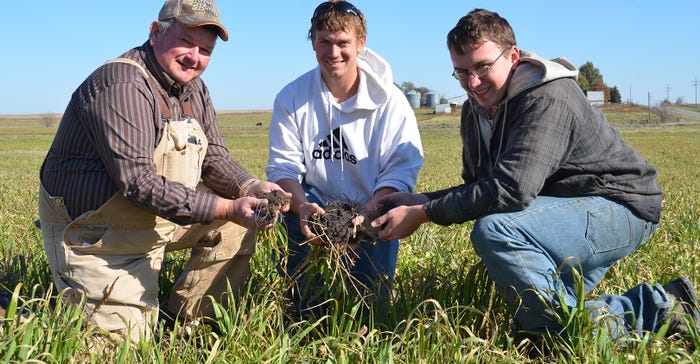
Editor’s note: Missouri Ruralist begins a new feature, “Focus on Soil Health,” with this story.
Ron Willis grew up in the “Dark Ages” of tilling the fields before planting and after harvest. With every pass, he saw some of the most productive topsoil of the family farm lying bare, susceptible to loss from rain or wind. When Ron purchased his own piece of land, he enacted change.
Ron, at left in the photo above, along with his sons Michael (center) and Matthew, are using no-till and cover crop farming practices to improve the health of the soils on their farm outside of King City, Mo. They have already seen an increase in organic matter.
He read about no-till practices in agriculture publications. “I thought it looks like it can save on fuel and help reduce soil erosion," Ron says. “So I decided to give it a try.”
In 1986, he purchased his first acres and started no-tilling crops. “The biggest fallacy in farming is that you have to till the ground to get water to seep in,” Ron says. Actually, he finds that the roots provide a channel for the rain to infiltrate the soil while keeping the topsoil in place. Some 30 years later, all of his 1,000 acres in Andrew County are no-tilled.
Back in the day, Ron was considered a pioneer in no-till. He and a group of farmers even created the Andrew County No-Till Club. But as in many areas of agriculture, the methods to improve soil health are changing.
New direction
Today, son Michael Willis may consider his father a part of the Dark Ages of no-till. In 2006, while attending Northwest Missouri State University as a broadcast journalism major, Michael was taking a soils class as an elective. It was there he learned of the need to improve soil health through another farming practice — cover crops.
Michael returned to the family farm and shared his knowledge and ideas with his father. Ron was open to them both. “We are committed to using practices that improve soil health,” he says. “Cover crops seemed like a practice that would improve organic matter in the soil. The combination of no-till and cover crops is working. Since 1986, I’ve seen a 1% increase in organic matter over the entire farm.”
Health benefits
Before planting, the father-son duo sampled the soil to determine a health baseline. In 2012, they sowed their first winter cover crops on several fields. Today, depending on crop rotation and weather, they drill a mix of turnips, crimson clover and oilseed radish, and soybeans or corn when they have leftovers.
The Willises have seen improvement in organic matter in the soil. According to Michael, all fields with cover saw a half-percent increase in organic matter.
They also found less need for fertilization.
One field required 150 pounds of nitrogen fertilizer to produce 150 bushels of corn. However, after adopting no-till and cover crop agriculture practices, it only requires 95 pounds of nitrogen.
Bringing it back to erosion
The family farms on a corn-soybean rotation. Roughly half of what is planted to soybeans the following year is cover cropped into corn stubble in the fall.
Michael decided to plant cereal rye near ditches where the family continued to have erosion problems. After a big rain event — an inch per hour — the father and son went to check the field. They saw soil and cornstalks running straight toward the ditch. “But it all stopped at the cornstalks,” Ron says.
“You could tell [cover crops] made a difference,” Michael adds.
For the Willis family, it is about keeping the soil healthy and in the field. Using cover crops is a new method with old roots.
“Cover crops are an old practice,” Michael says. “It started after the Dust Bowl.” However, he says that today, farmers are taking it to the next level.
“It is a more scientific approach,” Michael explains. “In the past decade, we started looking at the microbiology of the soil and seeing how these types of crops are making a difference in soil health.”
Building the farm
For Ron, incorporating farming practices that improve soil health is one way to make sure his King City, Mo., farm is sustainable for future generations. His sons agree.
Both Michael and younger brother Matthew are part of the farming operation.
Michael looks at the soil similarly to his long-term stock investments. “You make these short-term investments of seed and drilling, but then year after year, you are able to reap the dividends as soil health improves, fertilizer costs go down and yields increase.”
“Some farmers have the ‘shiny, new’ mentality,” Matthew says. “They look for a new piece of equipment to fix everything. Working with nature is a slow process, but if you work with it over a period of time, it will improve your ground for life.”
About the Author(s)
You May Also Like






